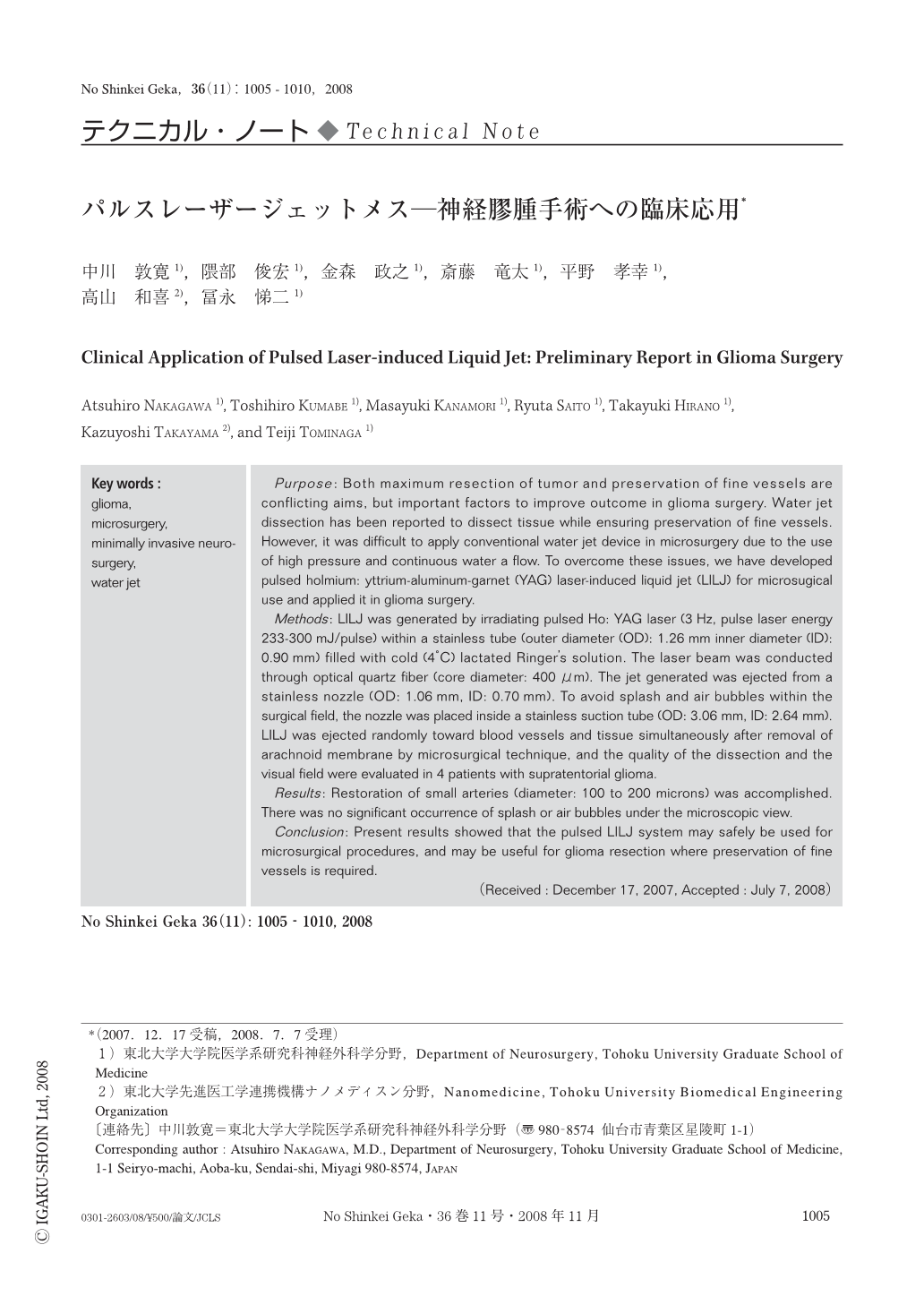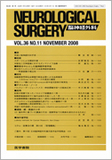Japanese
English
- 有料閲覧
- Abstract 文献概要
- 1ページ目 Look Inside
- 参考文献 Reference
Ⅰ.はじめに
液体(水)ジェットメスは水流により組織を線状に切開,もしくは体積をもつ塊として破砕するデバイスである.最大の特徴は熱損傷がない点と高い組織選択性をもち細血管(200μm程度)温存下に組織切開・破砕が可能である点である21,26).こうした特性は早くから注目され,25年以上前から腹部外科を中心に臨床応用されてきた21).特に,脳と同様に細血管からの出血や胆管損傷の処置に難渋する肝切除術では,既存の手術デバイス(超音波手術装置)と比較して手術時間短縮と出血量減少効果が報告されている7).その一方,従来の液体ジェットメスでは術野外に飛沫が飛散することによる播種や医療従事者への感染の危険性,術野内での気泡発生や水分貯留による視野悪化,微調整や小型化が困難といった問題から顕微鏡手術機器としては普及していないのが実情である.
工学的には,前述の問題点は高圧連続流の利用が少なからず関与しているものと考えられる2).パルスレーザージェットメスは,holmium:yttrium-aluminum-garnet(以下Ho:YAG,ホルミウムヤグ)レーザーを駆動源として,実効水量が極めて微量の高速液体ジェットをパルス状に発生させ組織の切開・破砕を行うデバイスである.これまでの基礎実験では,効果ならびに安全性に関して従来の液体ジェットメスと同等以上であることを報告してきた3-6,10,13-15,20,24).2007年3月に東北大学病院倫理委員会の承認を得て同年5月から臨床応用を開始し,これまでテント上神経膠腫4例において使用した経験を報告する.
Purpose: Both maximum resection of tumor and preservation of fine vessels are conflicting aims, but important factors to improve outcome in glioma surgery. Water jet dissection has been reported to dissect tissue while ensuring preservation of fine vessels. However, it was difficult to apply conventional water jet device in microsurgery due to the use of high pressure and continuous water a flow. To overcome these issues, we have developed pulsed holmium: yttrium-aluminum-garnet (YAG) laser-induced liquid jet (LILJ) for microsugical use and applied it in glioma surgery.
Methods: LILJ was generated by irradiating pulsed Ho: YAG laser (3Hz, pulse laser energy 233-300mJ/pulse) within a stainless tube (outer diameter (OD): 1.26mm inner diameter (ID): 0.90mm) filled with cold (4°C) lactated Ringer's solution. The laser beam was conducted through optical quartz fiber (core diameter: 400μm). The jet generated was ejected from a stainless nozzle (OD: 1.06mm, ID: 0.70mm). To avoid splash and air bubbles within the surgical field, the nozzle was placed inside a stainless suction tube (OD: 3.06mm, ID: 2.64mm). LILJ was ejected randomly toward blood vessels and tissue simultaneously after removal of arachnoid membrane by microsurgical technique, and the quality of the dissection and the visual field were evaluated in 4 patients with supratentorial glioma.
Results: Restoration of small arteries (diameter: 100 to 200 microns) was accomplished. There was no significant occurrence of splash or air bubbles under the microscopic view.
Conclusion: Present results showed that the pulsed LILJ system may safely be used for microsurgical procedures, and may be useful for glioma resection where preservation of fine vessels is required.

Copyright © 2008, Igaku-Shoin Ltd. All rights reserved.


